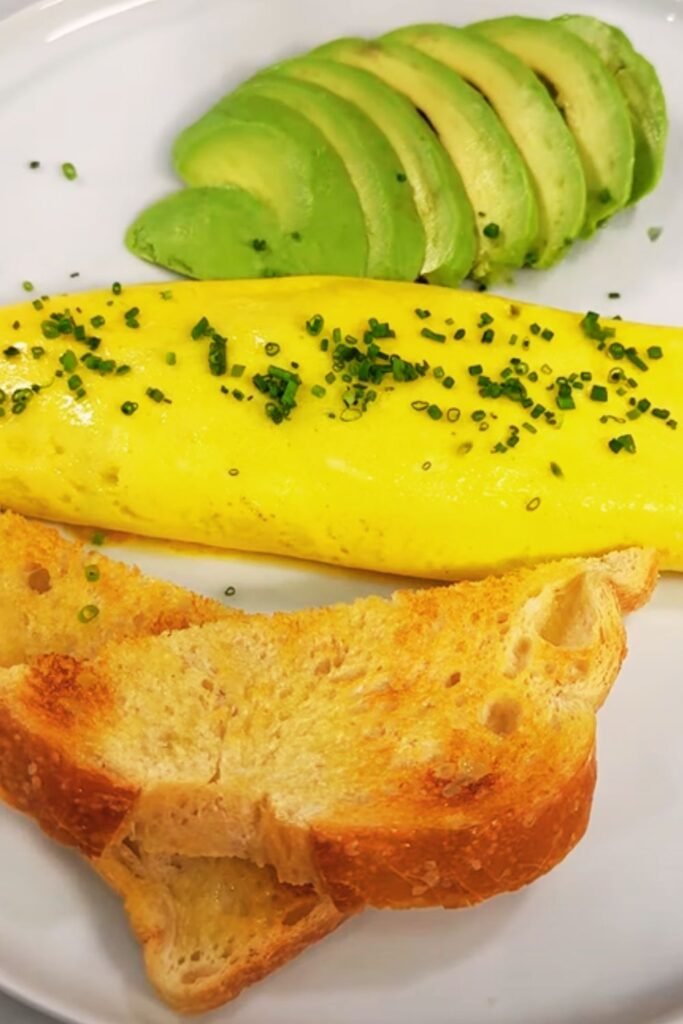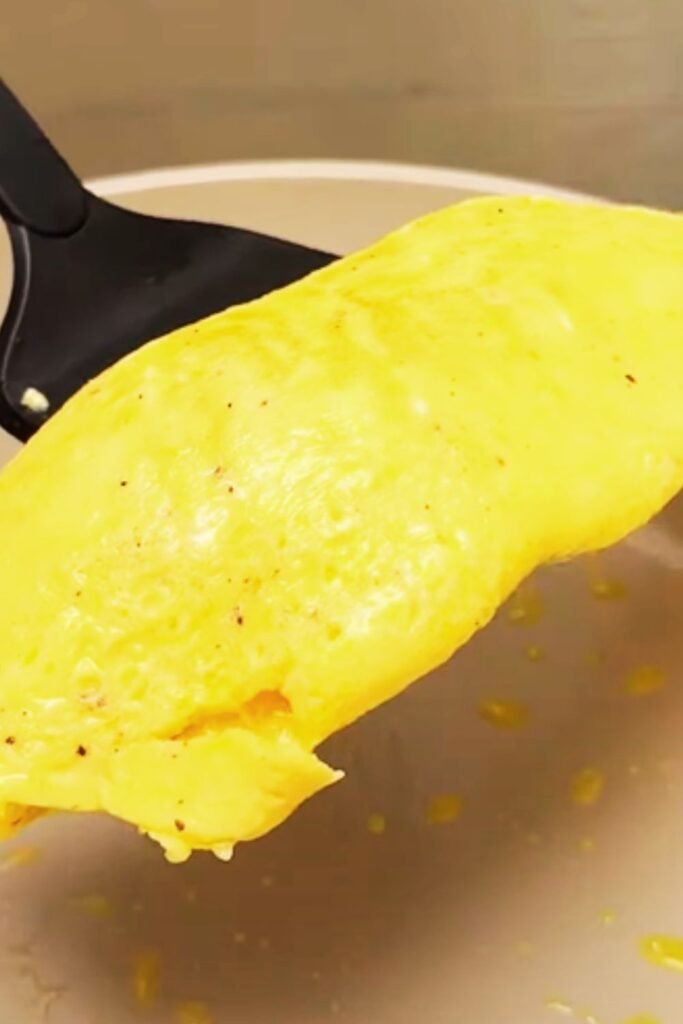Have you ever watched in awe as a French chef effortlessly creates that perfectly pale, delicately folded omelette with a creamy interior that seems to defy the laws of egg cookery? I certainly have, and for years I convinced myself that such culinary magic was beyond my humble home kitchen abilities. I was wrong—and I’m here to ensure you don’t make the same mistake.
The French omelette is one of those deceptively simple dishes that reveals the true essence of cooking: transforming basic ingredients into something transcendent through technique rather than complexity. With just eggs, butter, salt, and about 60 seconds of cooking time, you can create something truly remarkable.
What Makes a French Omelette Different?
Unlike its American counterpart (which is typically browned, fully set, and loaded with fillings), a traditional French omelette is:
Pale yellow with no browning Rolled or folded into an elegant oval or rectangle Creamy and slightly runny in the center Minimally filled, if at all Cooked incredibly quickly (often under 1 minute)
This isn’t breakfast as fuel—it’s breakfast as art. Yet despite its refined appearance, it’s actually one of the most approachable cooking techniques once you understand the fundamental principles.
The Science Behind the Perfect Omelette
Before we dive into technique, let’s understand why French omelettes work the way they do:
Egg proteins: When heated, the proteins in eggs begin to coagulate and set around 144°F (62°C). A French omelette maintains some proteins in a semi-coagulated state for that creamy interior.
Butter’s role: Beyond flavor, butter creates a fat barrier between the pan and eggs, preventing browning and sticking. The milk solids in butter also contribute to flavor development.
Agitation effect: The constant stirring in the early stage creates small curds while preventing any part from overcooking, resulting in that consistent texture.
Temperature gradient: The quick cooking creates a temperature differential from the outside to the inside of the omelette, giving you that perfect textural contrast.
Essential Ingredients
For a classic French omelette, quality matters more than quantity:
- Eggs: Farm-fresh eggs with vibrant yolks make a noticeable difference. Room temperature eggs cook more evenly than cold ones.
- Butter: Use European-style butter with higher fat content if possible. The butter should be cold for perfect browning.
- Salt: Fine sea salt dissolves quickly and distributes evenly.
- Fresh herbs: Traditional choices include chives, chervil, tarragon, or parsley.
Optional but authentic additions:
- A splash of cold water (creates steam for fluffiness)
- A touch of crème fraîche (added at the end for extra creaminess)
Essential Equipment
You don’t need fancy equipment, but these items make a difference:
- 8-inch non-stick skillet: The perfect size for a 2-3 egg omelette
- Silicone spatula: Flexible enough to curl around the pan edges
- Fork or small whisk: For thorough egg beating
- Warm plate: Essential—a cold plate will instantly cool your perfect creation

The Classic French Omelette: Step by Step
Preparation
- Crack 2-3 room temperature eggs into a bowl
- Season with a pinch of fine sea salt
- Beat eggs until just combined (about 20 seconds)—overbeating incorporates too much air
- Have your warm plate ready beside the stove
Cooking Technique
- Heat your non-stick pan over medium-high heat until you can feel warmth hovering your hand over it
- Add 1 tablespoon cold butter and swirl vigorously
- Just as the butter stops foaming but before it browns, pour in your eggs
- Immediately begin stirring rapidly with your spatula in a circular motion, creating small curds
- As eggs begin setting (about 20 seconds in), stop stirring and give the pan a shake to distribute any remaining liquid
- Tilt the pan at a 45-degree angle away from you, using your spatula to fold the edge closest to you about 1/3 of the way
- Using the pan’s edge and your spatula, continue rolling the omelette onto itself
- When almost completely rolled, flip onto a warm plate seam-side down
Total cooking time: 45-60 seconds—yes, that quick!
The Critical Moment
The perfect moment to start folding is when the eggs are set enough to hold shape but still glossy on top. Wait too long and you lose the creamy interior; too early and the omelette becomes impossible to shape. This moment arrives suddenly—be vigilant!
Common Mistakes and Troubleshooting
| Problem | Cause | Solution |
|---|---|---|
| Browned exterior | Pan too hot or cooked too long | Use medium heat and keep cooking time under 1 minute |
| Dry, rubbery texture | Overcooked or eggs beaten too vigorously | Cook more gently; beat eggs just until combined |
| Runny, undercooked | Not enough initial heat or inadequate pan contact | Ensure pan is properly preheated; use proper stirring technique |
| Fails to fold properly | Too many fillings or improper timing | Use minimal fillings; start folding when eggs are glossy but nearly set |
| Sticks to pan | Insufficient butter or damaged non-stick surface | Use enough butter; replace worn cookware |
| Flat appearance | Not enough air incorporated or pan too small | Beat eggs properly; use appropriate pan size |
Classic French Omelette Variations
The beauty of mastering the basic technique is that you can then explore these traditional variations:
Fines Herbes Omelette
The most classic French omelette variation:
- Add 1 teaspoon each of finely chopped chervil, chives, parsley, and tarragon to the beaten eggs
- Proceed with standard technique
- Garnish with additional fresh herbs
Gruyère Omelette
- Sprinkle 2 tablespoons of freshly grated Gruyère cheese over the eggs just before folding
- The residual heat will melt the cheese perfectly
- Add a pinch of white pepper for authentic flavor
Mushroom Omelette (Omelette aux Champignons)
- Sauté 1/4 cup finely diced mushrooms in butter until golden
- Set aside mushrooms before making omelette
- Add mushrooms just before folding

Advanced Techniques
Once you’ve mastered the basic French omelette, try these techniques to elevate your skills:
The Rolled Cylinder
This is the technique used in many fine dining establishments:
- Follow standard technique but use slightly lower heat
- Instead of folding in thirds, roll the omelette from one edge using your spatula
- Roll onto the plate so the seam is completely hidden underneath
- Traditionally finished with a light brush of butter for shine
Soufflé Omelette
- Separate eggs, beat whites to soft peaks
- Fold yolks back into whites gently
- Cook over very low heat with a lid
- Fold once when bottom is set but top is still slightly runny
The Authentic French Omelette Experience
In France, an omelette is often enjoyed as a light dinner rather than breakfast, typically accompanied by:
- A simple green salad dressed with vinaigrette
- Crusty baguette
- Fresh seasonal fruit
For a complete French experience, serve your omelette with:
- Mesclun greens tossed with Dijon vinaigrette
- Sliced tomatoes with flaky sea salt
- Fresh-squeezed orange juice
- Café au lait
Nutritional Profile
A basic French omelette offers impressive nutritional benefits:
| Nutrient | Amount (per 3-egg omelette) | % Daily Value |
|---|---|---|
| Protein | 18g | 36% |
| Fat | 15g | 23% |
| Carbohydrates | <1g | <1% |
| Vitamin D | 87 IU | 22% |
| Vitamin B12 | 1.6 mcg | 67% |
| Choline | 398 mg | 72% |
| Selenium | 39 mcg | 71% |
| Calories | 221 | 11% |
The nutrient density makes it an excellent option for those following low-carbohydrate or ketogenic diets, while providing essential nutrients for brain health.
My Journey to Omelette Mastery
I’ll never forget my first attempt at a French omelette. After watching a renowned chef demonstrate the technique with effortless grace, I confidently cracked my eggs, heated my pan, and proceeded to create what I can only describe as scrambled eggs with identity issues.
Six tries later, with a counter full of misshapen egg casualties, I finally had my eureka moment. The key wasn’t in the ingredients or even the recipe—it was in developing a feel for the eggs, understanding the precise moment when they transformed from liquid to that perfect semi-set state.
Now, years later, making a French omelette has become almost meditative—a minute of complete focus that results in something greater than the sum of its parts.

Beyond Breakfast: Creative Serving Ideas
While traditionally enjoyed on its own, a French omelette can become the centerpiece of a delightful meal:
- Serve alongside asparagus spears tossed in brown butter
- Top with a small dollop of crème fraîche and salmon roe for an elegant appetizer
- Create a deconstructed Nicoise by serving alongside haricots verts, olives, and tomatoes
- For a hearty meal, pair with roasted fingerling potatoes and a side of sautéed greens
Seasonal Adaptations
The French embrace seasonality, and you can adapt your omelette accordingly:
Spring: Fresh peas, young asparagus tips, or morel mushrooms Summer: Heirloom tomato concassé, fresh corn, or basil Fall: Wild mushrooms, roasted butternut squash, or sage Winter: Truffle shavings, caramelized onions, or sautéed leeks
Questions & Answers
How do I know when my pan is the right temperature? The perfect temperature is when butter sizzles gently upon contact but doesn’t immediately brown. If your butter browns within 5 seconds, your pan is too hot. If it barely melts, it’s too cool.
Why do chefs add water to omelette eggs? A small splash of water (about 1 teaspoon per 3 eggs) creates steam during cooking, which helps make the texture fluffier while preventing toughness. Cold water works better than room temperature.
Can I make a French omelette without a non-stick pan? Yes, but it requires extra skill. A well-seasoned carbon steel pan works wonderfully once you’ve mastered the technique. Just be sure to use plenty of butter.
My omelette always breaks when I try to fold it. What am I doing wrong? You’re likely allowing the eggs to cook too long before folding. Start the folding process when the top is still slightly wet but not completely runny.
How can I add fillings without ruining the delicate texture? Pre-cook any fillings separately, then add them sparingly just before folding. Alternatively, serve them on top of your finished omelette.
Is a French omelette supposed to be runny inside? Not runny, but creamy. The interior should have the consistency of soft custard—set but not liquid. If you prefer a firmer interior, simply allow it to cook 10-15 seconds longer before folding.
Can I make a French omelette for multiple people at once? It’s best to make individual omelettes one at a time. They cook so quickly that you can make several in succession while keeping the finished ones in a warm oven (though they’re truly best served immediately).
How important is the type of eggs used? Very. Farm-fresh eggs with deep yellow yolks not only provide better flavor but also the right consistency. Older eggs tend to spread more in the pan and don’t hold their shape as well.
French Omelette: A Canvas for Creativity
While I’ve emphasized traditional techniques, remember that cooking is ultimately about pleasure—both in the making and the eating. Once you’ve mastered the classic method, feel free to make it your own.
I’ve seen extraordinary variations incorporating everything from finely diced ratatouille to truffle shavings. The key is maintaining that fundamental technique while allowing your creativity to shine through the additions.
What makes the French omelette truly special isn’t just its elegant appearance or velvety texture—it’s the way it transforms the humblest of ingredients into something that feels luxurious. It reminds us that true culinary mastery often lies not in complexity, but in elevating simplicity through perfect execution.
Whether you’re making a quick breakfast for yourself or impressing weekend guests, the French omelette offers a perfect combination of approachability and refinement. With a little practice, patience, and perhaps a few sacrificial eggs along the way, you’ll soon be creating omelettes that would make a Parisian chef proud.
Q&A Section
What is the difference between a French omelette and an American omelette? A French omelette is pale yellow with no browning, rolled or folded into an elegant shape, creamy in the center, and minimally filled. An American omelette is typically fully cooked through, browned on the outside, and filled with various ingredients like cheese, vegetables, and meats.
Can I make a French omelette without butter? While butter is traditional and provides the best flavor, you can substitute with a high-quality olive oil. However, the texture and flavor profile will be noticeably different. Butter contributes not just fat but also milk solids that impact the final taste.
How many eggs should I use for one person? The classic French omelette uses 2-3 eggs per person. Using more than 3 eggs makes the omelette difficult to handle and fold properly, especially for beginners.
My omelette keeps sticking to the pan. What am I doing wrong? There are three likely causes: your pan isn’t truly non-stick, you’re not using enough butter, or your heat is too high. Make sure to use a good quality non-stick pan, adequate butter, and medium-high heat rather than high heat.
Is it better to add salt before or after cooking the eggs? Adding salt to the eggs before cooking actually helps break down the proteins slightly, resulting in a more tender omelette. Season your eggs about 30 seconds before cooking for optimal results.
How long should I beat the eggs? For a French omelette, beat the eggs just until the whites and yolks are combined—about 20-30 seconds. Overbeating incorporates too much air and can result in an omelette that puffs up then deflates.
Can I make a French omelette ahead of time? A French omelette is at its absolute best when served immediately. The delicate texture changes quickly as it cools, and reheating will overcook it. If timing is an issue, prepare all ingredients ahead of time so you can cook the omelette at the last minute.
What herbs work best in a French omelette? The traditional fines herbes mixture includes equal parts chervil, chives, parsley, and tarragon. However, you can use whatever fresh herbs you enjoy or have available. Soft herbs work better than woody ones like rosemary or thyme.